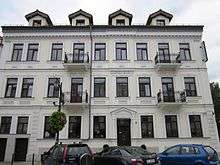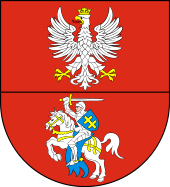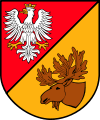Białystok
Białystok (UK: /biːˈælɪstɒk/,[4] US: /biːˈɑːlɪstɔːk, ˈbjɑː-, bjɑːˈwɪstɔːk/,[5][6][7] Polish: [bjaˈwɨstɔk] (![]()
Białystok | |
|---|---|
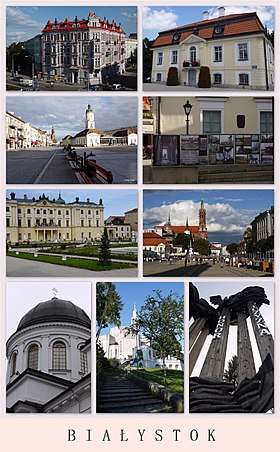 | |
 Flag 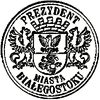 Seal  Coat of arms | |
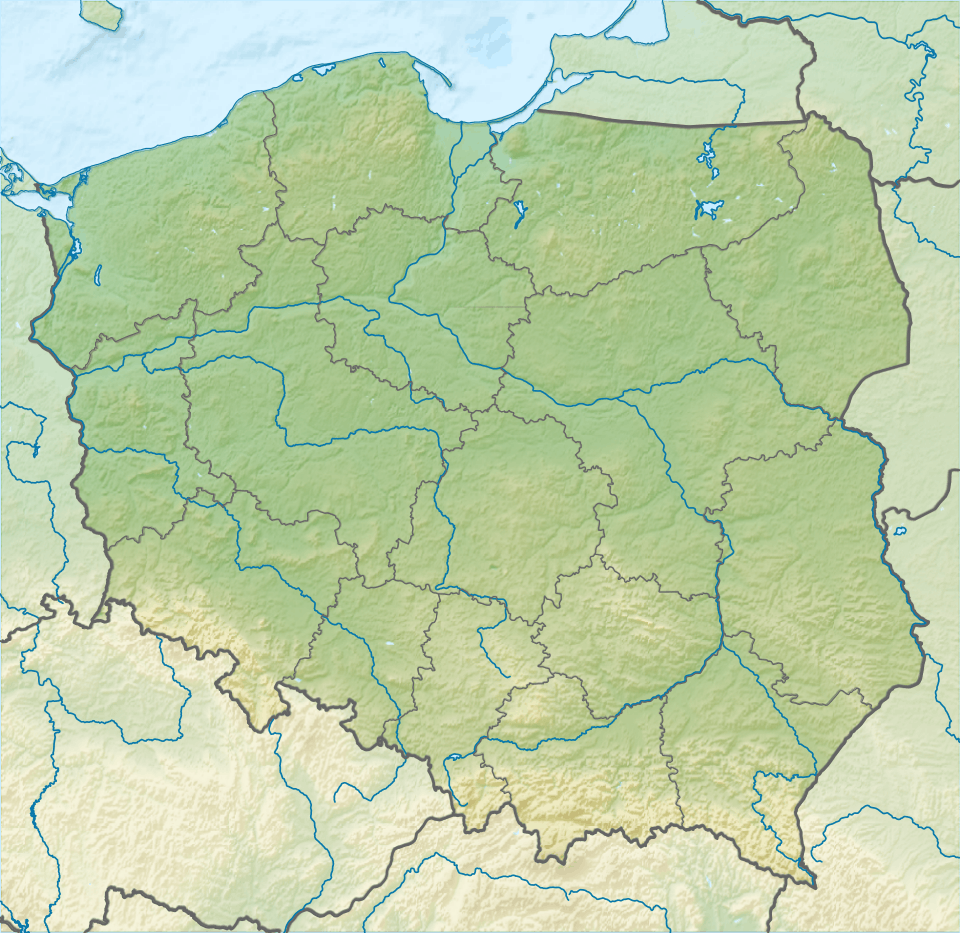 Białystok 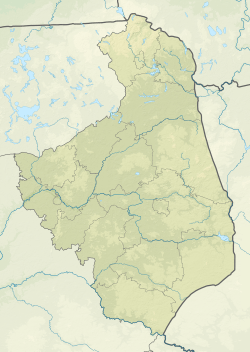 Białystok | |
| Coordinates: 53°08′07″N 23°08′44″E | |
| Country | |
| Voivodeship | |
| County | city county |
| Established | 1437 |
| Town rights | 1692 |
| Districts | |
| Government | |
| • Mayor | Tadeusz Truskolaski[2] (PO) |
| Area | |
| • City | 102.12 km2 (39.43 sq mi) |
| Highest elevation | 160 m (520 ft) |
| Lowest elevation | 120 m (390 ft) |
| Population (31 December 2019) | |
| • Urban | 297,554 |
| • Metro | 430,000 |
| Time zone | UTC+1 (CET) |
| • Summer (DST) | UTC+2 (CEST) |
| Postal code | 15-001 |
| Area code(s) | +48 85 |
| Car plates | BI |
| Website | www |
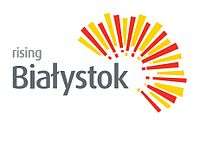 | |
Białystok is located in the Białystok Uplands of the Podlaskie Plain on the banks of the Biała River. It has historically attracted migrants from elsewhere in Poland and beyond, particularly from Central and Eastern Europe. This is facilitated by the nearby border with Belarus also being the eastern border of the European Union, as well as the Schengen Area. The city and its adjacent municipalities constitute Metropolitan Białystok. The city has a warm summer continental climate, characterized by warm summers and long frosty winters. Forests are an important part of Białystok's character, and occupy around 1,756 ha (4,340 acres) (17.2% of the administrative area of the city) which places it as the fifth-most forested city in Poland.
The first settlers arrived in the 14th century. A town grew up and received its municipal charter in 1692. Białystok has traditionally been one of the leading centers of academic, cultural, and artistic life in Podlachia and the most important economic center in northeastern Poland. Białystok was once an important center for light industry, which was the reason for the substantial growth of the city's population. The city continues to reshape itself into a modern middle-sized city. Białystok, in 2010, was on the short-list, but ultimately lost the competition, to become a finalist for European Capital of Culture in 2016.
Etymology
The English translation of Białystok is "white slope".[8] Due to changing borders and demographics over the centuries, the city has been known as Belarusian: Беласток (Byelastok?, Biełastok? [bʲeɫaˈstok]), Yiddish: ביאַליסטאָק (Byalistok, Bjalistok), Lithuanian: Baltstogė, Balstogė, and Russian: Белосток (Byelostok).
Linguist A. P. Nepokupnyj proposes that the language source for Białystok is Yotvingian. Names with the -stok suffix as a second element of a hydronym are localized in the basin of the upper Narew.[9]
History
Archaeological discoveries show that the first settlements in the area of present-day Białystok occurred during the Stone Age. Tombs of ancient settlers can be found in the district of Dojlidy.[10] In the early Iron Age, people settled in the area producing kurgans, the tombs of the chiefs in the area located in the current village of Rostołty.[11] Since then, the Białystok area has been at the crossroads of cultures. Trade routes linking the Baltic to the Black Sea favored the development of settlements with Yotvingia-Ruthenian-Polish cultural characteristics.[11]
The city of Białystok has existed for five centuries and during this time the fate of the city has been affected by various political and economic forces.
Surviving documents attest that around 1437 a representative of the Raczków family, Jakub Tabutowicz of the coat of arms Łabędź, received from Michael Žygimantaitis son of Sigismund Kęstutaitis, Duke of Lithuania, a wilderness area along the river Biała that marked the beginning of Białystok as a settlement.[12][13] Białystok administratively was part of the Podlaskie Voivodeship, after 1569 also part of the Lesser Poland Province of the Crown of the Kingdom of Poland.
From 1547, the settlement was owned by the Wiesiołowski family, which founded the first school.[14] The first brick church and a castle were built between 1617 and 1826. The two-floor castle, designed on a rectangular plan in the Gothic-Renaissance style, was the work of Job Bretfus. Extension of the castle was continued by Krzysztof Wiesiołowski, starost of Tykocin, Grand Marshal of Lithuania since 1635, and husband of Aleksandra Marianna Sobieska.[15] In 1637 he died childless, and as a result Białystok came under the management of his widow. After her death in 1645 the Wiesiołowski estate, including Białystok, passed to the Crown to cover the costs of maintaining Tykocin Castle. In the years 1645–1659 Białystok was managed by the starosts of Tykocin.[15][16]
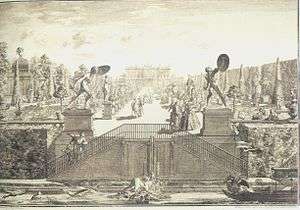
In 1661 it was given to Stefan Czarniecki as a reward for his service in the victory over the Swedes during the Deluge. Four years later, it was given as a dowry of his daughter Aleksandra, who married Marshal of the Crown Court Jan Klemens Branicki, thus passing into the hands of the Branicki family.[17][18] In 1692, Stefan Mikołaj Branicki, the son of Jan Klemens Branicki, obtained city rights for Białystok from King John III Sobieski. He constructed the Branicki Palace on the foundations of the castle of the Wiesiołowski family.[19] In the first half of the eighteenth century the ownership of the city was inherited by Field Crown Hetman Jan Klemens Branicki.[8] It was he who transformed the palace built by his father into a magnificent residence of a great noble,[20][21] which was frequently visited by Polish kings and poets.[22] In 1745 the first military technical school in Poland was founded in Białystok,[23] and in 1748, one of the oldest theaters in Poland, the Komedialnia, was founded in the city.[24] New schools were established, including a ballet school in connection with the foundation of the theater.[25] In 1749, King Augustus III of Poland extended the city limits.[14] In 1770, under the auspices of Izabella Poniatowska, a midwifery school was founded, based on which the Institute of Obstetrics was established in 1805.[23]
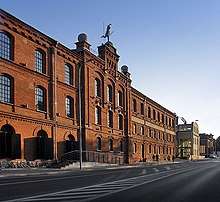
The end of the eighteenth century saw the division of the Polish–Lithuanian Commonwealth, in three steps, among the neighboring states. The Kingdom of Prussia acquired Białystok and the surrounding region during the third partition. The city became the capital of the New East Prussia province in 1795.[26] Prussia lost the territory following Napoleon Bonaparte's victory in the War of the Fourth Coalition as the resultant 1807 Treaties of Tilsit awarded the area to the Russian Empire, which organized the region into the Belostok Oblast,[27] with the city as the regional center.[28] Schooling and higher learning in Białystok, which was intensively developed in the 18th century, was stopped as a result of partitions.[23] Later in the 19th century, Białystok grew into a significant center of the textile industry, the largest after Łódź in then-partitioned Poland. In 1862 a railway connection was launched, connecting Białystok with Warsaw, Grodno, Wilno and Saint Petersburg. After the failed November and January uprisings, Russification policies and anti-Polish repressions intensified, and after 1870 a ban on the use of Polish in public places was introduced.[22]
At the end of the nineteenth century, as a result of the influx due to Russian discriminatory regulations, the majority of the city's population was Jewish. According to Russian census of 1897, out of the total population of 66,000, Jews constituted 41,900 (so around 63% percent).[29] This heritage can be seen on the Jewish Heritage Trail in Białystok.[30] The Białystok pogrom occurred between 14–16 June 1906 in the city. During the pogrom between 81 and 88 people were killed by the Russians, and about 80 people were wounded.[31][32][33]
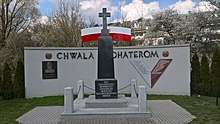
The first Anarchist groups to attract a significant following of Russian workers or peasants, were the Anarcho-Communist Chernoe-Znamia groups, founded in Białystok in 1903.[34][35]
.jpg)
During World War I the Bialystok-Grodno District was the administrative division of German-controlled territory of Ober-Ost. It comprised the city, as the capital, and the surrounding Podlaskie region, roughly corresponding to the territory of the earlier Belostok Oblast.[36][37] At the end of World War I the city became part of the newly independent Second Polish Republic, as the capital of the Białystok Voivodeship (1919–1939).[38] During the 1919–1920 Polish–Soviet War, possession of the city by the Red Army and the Provisional Polish Revolutionary Committee occurred during the lead up to the Battle of Warsaw. During the resultant counteroffensive, the city returned to Polish control after the Battle of Białystok.
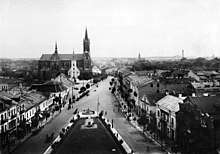
After the wars and the reestablishment of independent Poland, Polish education in Białystok was restored and the textile industry was revived.[22] A municipal public library was established, sports clubs were founded, including Jagiellonia Białystok, and in the 1930s a dramatic theater was built.[22]
With the beginning of World War II, Poland was invaded by Nazi Germany and the Soviet Union, and initially the city came under Soviet occupation, as a result of the Molotov–Ribbentrop Pact. It was incorporated into the Byelorussian SSR from 1939 to 1941 as the capital of Belastok Region.[39][40] Polish people were subject to deportations deep into the USSR (Siberia, Kazakhstan, Far North).[41] In the course of the German invasion of the Soviet Union in 1941, Białystok was occupied by the German Army on 27 June 1941, during the Battle of Białystok–Minsk, and the city became the capital of Bezirk Białystok, a separate region in German occupied Poland, until 1944.[42][43] The Great Synagogue was burnt down by Germans on June 27, 1941, with an estimated number of 2,000 Jews inside.
From the very beginning, the Nazis pursued a ruthless policy of pillage and removal of the non-German population. The 56,000 Jewish residents of the town were confined in a ghetto.[44] On August 15, 1943, the Białystok Ghetto Uprising began, and several hundred Polish Jews and members of the Anti-Fascist Military Organisation (Polish: Antyfaszystowska Organizacja Bojowa) started an armed struggle against the German troops who were carrying out the planned liquidation of the ghetto with deportations to the Treblinka extermination camp.[45]
The city fell under the control of the Red Army on 27 July 1944 and on 20 September 1944 was transferred to Poland. After the war, the city became capital of the initial Białystok Voivodeship (1945–1975) of the People's Republic of Poland.[46][47][48] After the 1975 administrative reorganization, the city was the capital of the smaller Białystok Voivodeship (1975–1998).[49] Since 1999 it has been the capital of the Podlaskie Voivodeship, Republic of Poland.[49]
Geography
Białystok is situated in the Białystok Uplands (Polish: Wysoczyzna Białostocka) of the Podlaskie Plain (Polish: Nizina Północnopodlaska), part of what is known collectively as the Green Lungs of Poland.[50][51] It is the biggest Polish city close to Belarus and Lithuania. The Biała River, a left tributary of the Supraśl River, passes through the city. The landscape of the Białystok Upland is diverse, with high moraine hills and kame in excess of 200 m (660 ft) above sea level. Vast areas of outwash, a glacial plain formed of sediments deposited by meltwater at the terminus of a glacier, are covered by forests.[51]
Forests are an important part of the city character, they currently occupy approximately 1,756 ha (4,340 acres) (17.2% of the administrative area of the city) which places it as the fifth most "wooded" city in Poland; behind Katowice (38%), Bydgoszcz (30%), Toruń (22.9%) and Gdańsk (17.6%).[52]
Part of Knyszyn Forest is preserved within the city limits by two nature reserves—a total area of 105 ha (260 acres).[53] The Zwierzyniecki Forest Nature Reserve (Polish: Rezerwat przyrody Las Zwierzyniecki), which is contained within the city limits, is a fragment, 33.48 ha (82.7 acres), of the riparian forest with a dominant assemblage of oak and hornbeam.[54] The Antoniuk Nature Reserve (Polish: Rezerwat Przyrody Antoniuk) is a 70.07 ha (173.1 acres) park in the city that preserves the natural state of a forest fragment characteristic of the Białystok Upland, with a dominant mixed forest of hazel and spruce.[55]
The 40 ha (99 acres) of forests lying in the vicinity of the Dojlidy Ponds are administered by the Central Sports and Recreation Center in Białystok (Polish: Miejski Ośrodek Sportu i Rekreacji w Białymstoku – MOSiR). The Dojlidy Ponds recreation area includes a public beach, walking trails, birdwatching and fishing.[56]
Climate
The city has a mild-summer continental or hemiboreal climate (Dfb) according to the Köppen climate classification system, characterized by warm temperatures during summer and long and frosty winters.[57] It is substantially different from most of the other Polish lowlands.[57] The region is one of the coldest in Poland, with the average temperature in January being −3.7 °C (25 °F).[57] The average temperature in a year is about 7 °C (45 °F).[57] The number of frost days ranges from 50 to 60, with frost from 110 to 138 days and the duration of snow cover from 90 to 110 days.[57] Mean annual rainfall values oscillate around 567 mm (22.3 in), and the vegetation period lasts 200 to 210 days.[57]
| Climate data for Białystok, 1980–2012 normals | |||||||||||||
|---|---|---|---|---|---|---|---|---|---|---|---|---|---|
| Month | Jan | Feb | Mar | Apr | May | Jun | Jul | Aug | Sep | Oct | Nov | Dec | Year |
| Record high °C (°F) | 12.0 (53.6) |
16.4 (61.5) |
20.0 (68.0) |
27.8 (82.0) |
31.1 (88.0) |
32.6 (90.7) |
36.1 (97.0) |
35.2 (95.4) |
31.1 (88.0) |
23.9 (75.0) |
17.2 (63.0) |
13.9 (57.0) |
36.1 (97.0) |
| Average high °C (°F) | −1.0 (30.2) |
−0.2 (31.6) |
4.9 (40.8) |
12.4 (54.3) |
18.4 (65.1) |
21.4 (70.5) |
23.2 (73.8) |
22.6 (72.7) |
17.4 (63.3) |
11.5 (52.7) |
4.5 (40.1) |
0.3 (32.5) |
11.3 (52.3) |
| Daily mean °C (°F) | −3.7 (25.3) |
−3.4 (25.9) |
0.7 (33.3) |
7.0 (44.6) |
12.4 (54.3) |
15.7 (60.3) |
17.6 (63.7) |
16.9 (62.4) |
12.3 (54.1) |
7.4 (45.3) |
2.0 (35.6) |
−2.2 (28.0) |
6.9 (44.4) |
| Average low °C (°F) | −6.4 (20.5) |
−6.6 (20.1) |
−3.5 (25.7) |
1.6 (34.9) |
6.4 (43.5) |
9.9 (49.8) |
11.9 (53.4) |
11.1 (52.0) |
7.1 (44.8) |
3.3 (37.9) |
−0.5 (31.1) |
−4.6 (23.7) |
2.5 (36.4) |
| Record low °C (°F) | −34.6 (−30.3) |
−31.1 (−24.0) |
−23.6 (−10.5) |
−8.0 (17.6) |
−5.0 (23.0) |
−0.2 (31.6) |
−1.1 (30.0) |
0.1 (32.2) |
−5.1 (22.8) |
−11.1 (12.0) |
−19.3 (−2.7) |
−29.0 (−20.2) |
−34.6 (−30.3) |
| Average precipitation mm (inches) | 22.0 (0.87) |
26.9 (1.06) |
29.8 (1.17) |
36.9 (1.45) |
60.3 (2.37) |
67.9 (2.67) |
80.3 (3.16) |
54.4 (2.14) |
59.1 (2.33) |
51.2 (2.02) |
44.1 (1.74) |
34.3 (1.35) |
567.2 (22.33) |
| Average precipitation days | 11.3 | 11.2 | 10.8 | 10.5 | 10.6 | 12.2 | 13.1 | 10.4 | 11.4 | 10.2 | 12.2 | 14.1 | 138 |
| Average rainy days | 7 | 7 | 8 | 9 | 7 | 8 | 8 | 7 | 8 | 9 | 9 | 6 | 93 |
| Average snowy days | 9 | 10 | 7 | 3 | 0 | 0 | 0 | 0 | 0 | 0 | 5 | 7 | 41 |
| Average relative humidity (%) | 90 | 90 | 80 | 70 | 70 | 75 | 75 | 75 | 85 | 85 | 90 | 95 | 82 |
| Mean monthly sunshine hours | 36.1 | 58.0 | 124.6 | 190.1 | 252.6 | 255.3 | 258.0 | 250.7 | 158.6 | 96.1 | 36.5 | 24.5 | 1,741.6 |
| Source: WeatherBase,[58] Climatebase.ru[59] and meteoblue.com[60] | |||||||||||||
| Climate data for Bialystok (Dojlidy), elevation: 148 m, 1961-1990 normals and extremes | |||||||||||||
|---|---|---|---|---|---|---|---|---|---|---|---|---|---|
| Month | Jan | Feb | Mar | Apr | May | Jun | Jul | Aug | Sep | Oct | Nov | Dec | Year |
| Record high °C (°F) | 10.9 (51.6) |
16.4 (61.5) |
21.8 (71.2) |
27.4 (81.3) |
30.1 (86.2) |
32.4 (90.3) |
34.8 (94.6) |
34.6 (94.3) |
29.8 (85.6) |
25.4 (77.7) |
16.8 (62.2) |
13.8 (56.8) |
34.8 (94.6) |
| Average high °C (°F) | −2.2 (28.0) |
−0.6 (30.9) |
4.4 (39.9) |
12.0 (53.6) |
18.4 (65.1) |
21.5 (70.7) |
22.6 (72.7) |
22.1 (71.8) |
17.4 (63.3) |
11.5 (52.7) |
4.6 (40.3) |
0.2 (32.4) |
11.0 (51.8) |
| Daily mean °C (°F) | −4.8 (23.4) |
−3.8 (25.2) |
0.2 (32.4) |
6.7 (44.1) |
12.9 (55.2) |
16.1 (61.0) |
17.3 (63.1) |
16.3 (61.3) |
12.0 (53.6) |
7.2 (45.0) |
2.2 (36.0) |
−2.1 (28.2) |
6.7 (44.0) |
| Average low °C (°F) | −7.7 (18.1) |
−6.8 (19.8) |
−3.4 (25.9) |
1.9 (35.4) |
7.0 (44.6) |
10.2 (50.4) |
11.7 (53.1) |
11.1 (52.0) |
7.6 (45.7) |
3.6 (38.5) |
−0.1 (31.8) |
−4.6 (23.7) |
2.5 (36.6) |
| Record low °C (°F) | −35.4 (−31.7) |
−32.9 (−27.2) |
−24.0 (−11.2) |
−8.3 (17.1) |
−4.5 (23.9) |
0.7 (33.3) |
5.0 (41.0) |
0.2 (32.4) |
−5.1 (22.8) |
−9.9 (14.2) |
−20.7 (−5.3) |
−26.2 (−15.2) |
−35.4 (−31.7) |
| Average precipitation mm (inches) | 35 (1.4) |
26 (1.0) |
31 (1.2) |
36 (1.4) |
56 (2.2) |
74 (2.9) |
80 (3.1) |
70 (2.8) |
52 (2.0) |
46 (1.8) |
46 (1.8) |
40 (1.6) |
592 (23.2) |
| Average precipitation days (≥ 1.0 mm) | 8.8 | 7.0 | 7.9 | 7.7 | 9.5 | 9.9 | 10.0 | 8.9 | 8.7 | 8.4 | 9.7 | 10.1 | 106.6 |
| Source: NOAA[61] | |||||||||||||
City layout
Bialystok is built in a round shape, centered around the old city Church Square and Branicki Palace. Originally, the city's territory was around 50 hectares. Throughout the years it expanded and accumulated nearby villages: In the mid eighteenth century Bojary which was located on the right bank of the Biala River was incorporated to it. On May 10, 1919, in according with the decision of the Sejm, Bialostoczek, Horodniany, Zwierzyniec-Letnisko, Starosielce, Słoboda (which was founded at the end of the 17th century, between the current Pogodna and Świerkowa Streets), Ogrodniki, Pieczurki, Wysoki Stoczek were incorporated also, as well as too mill villages Marczuk and Antoniuk. By the onset of World War II the city's territory amounted to 40km².[62] The reconstruction of the city following the end of World War II and establishment of the People's Republic of Poland saw further expansion: The villages Bacieczki, Bacieczki Kolonia, Korycin and part of the village Klepacze, Krupniki, Fasty, Zaścianki and Zawady were incorporated to the city. The 70s saw another wave of expansion with the villages of Bagnówka, area of Zakłady Silikatowe, areas of state forests, Dojlidy ponds and orthodox cemetery Dojlidy. At the onset of the millennium, in 2002, the village Zawady was included in the city's limits and in the last enlargement, in 2006, the villages Dojlidy Górne, Zagórki and Kolonia Halickie were incorporated and the city has reached its current territory of 102km².[63]
Districts
The city of Białystok is divided into 28 administrative units, known in Polish as osiedla.[64][65] The first 27 of these were created on October 25, 2004.[64] The 28th, Dojlidy Górne, was created by on October 23, 2006, out of three settlements which had been incorporated into the city: Dojlidy Górne, Kolonia Halickie, and Zagórki.[64]
The center of the city, Osiedle Centrum, surrounds Lipowa Street, the main street of the city. Lipowa Street extends from Rynek Kościuszki (the corner of Spółdzielcza Street) to Plac Niepodległości im. Romana Dmowskiego (the corner of Krakowska Street).[66] Over the centuries the name of this street has taken on a number of different names; Choroska, Nowolipie, Lipowa, Józef Piłsudski, Joseph Stalin, Adolf Hitler and Joseph Stalin, once again, to return, after the end of World War II, to its original name – Lipowa Street.
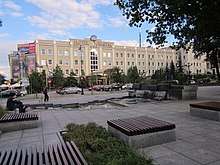
The city covers 10,212 ha (25,230 acres) of which 3,210 ha (7,900 acres) is agricultural land, 4,889 ha (12,080 acres) is urbanized areas, 85 ha (210 acres) is surface waters and 65 ha (160 acres) is wasteland.[67] The composition of the districts vary from residential near the city center, with a combination of multi-story apartment buildings and individual houses on small parcels, to industrial and agricultural at the city edges.[67]
Metropolitan Białystok
Metropolitan Białystok was designated by the Voivodeship of the Regulation No. 52/05 of 16 May 2005 [68] to help develop the region economically. In 2006, the metropolitan area population was 450,254 inhabitants.[69] The municipalities adjacent to Białystok are slowly losing their agricultural character, becoming residential suburban neighborhoods with single-family housing and small businesses.[70]
Demographics
In June 2009, the population of the city was 294,399.[70] Among the cities of Poland, Białystok is second in terms of population density, tenth in population, and thirteenth in area.[71] Historically, Białystok has been a destination for internal and foreign immigration, especially from Central and Eastern Europe. In addition to the Polish minority, there was formerly a Jewish majority in Białystok. The Jewish share in the population of Białystok grew from 22.4% (761) in 1765 to 66.6% (6,000) in 1808 and 76% (47,783) in 1895.[72] According to the Russian census of 1897, out of the total population of 66,000, Jews constituted 41,900 (around 63% percent).[29] According to the German census of 1916, Jews comprised about 72% of the inhabitants (no less than 40,000). The demographic situation changed due to the influx of Polish repatriants, intelligentsia and civil servants, the outflow of Jews, and the enlargement of the city after the World War I.[72] According to the 1931 census, the population of Białystok totalled 91,101: 45.5% (41,493) Roman Catholics, 43% (39,165) Jews (by religion), and 8.2% (7,502) Eastern Orthodox believers.[73][74]
In 1936, Białystok had a population of 99,722, of whom: 50.9% (50,758) were Poles, 42.6% (42,482) Jews, 2.1% (2,094) Germans and 0.4% (359) Russians; 46.6% (45,474) adhered to the Catholic religion, 43% (42,880) to Judaism, 8.2% (8,177) to Eastern Orthodoxy and 2.9% (2,892) to Evangelicalism.[72] World War II changed all of this: in 1939, around 107,000 people lived in Białystok,[75] but by 1946, the population had dropped to 56,759, with much less ethnic diversity than it had had previously.[44] Currently the city's population is 97% Polish, 2.5% Belarusian and 0.5% of a number of minorities including Russians, Lipka Tatars, Ukrainians and Romani.[76] Most of the modern-day population growth is based on internal migration within Poland and urbanization of surrounding areas.[76]
Governance
City government
Białystok, like other major cities in Poland, is a city county (Polish: Miasto na prawach powiatu).[77] The Legislative power in the city is vested in the unicameral Białystok City Council (Polish: Rada Miasta), which has 28 members.[78] Council members are elected directly every four years, one of whom is the mayor, or President of Białystok (Polish: prezydent).[78] Like most legislative bodies, the City Council divides itself into committees which have the oversight of various functions of the city government.[78] Bills passed by a simple majority are sent to the mayor, who may sign them into law.[78] If the mayor vetoes a bill, the Council has 30 days to override the veto by a two-thirds majority vote.[78] The current President of Białystok, elected for his first term in 2006, is Tadeusz Truskolaski won the elections as the Civic Platform's candidate, however, he has no official connection with the party. In the first round of the elections he received 49% of the votes (42,889 votes altogether). In the later runoff he defeated his rival candidate Marek Kozlowski from Law and Justice (Polish: Prawo i Sprawiedliwość), receiving 67% of the votes cast (53,018 votes).[79]
For the 2010–2011 fiscal year the city received revenue (taxes levied + investments) of 1,409,565,525 zł, expended 1,676,459,102 zł leaving a budget deficit of 266,893,577 zł.[80] The deficit was covered by short-term borrowing of 166,893,577 zł and the issuance of 100 million zł in municipal bonds.[80]
.jpg)
Other levels of governmental representation
It is also the seat of government for the Podlaskie Voivodeship.[81] The city is represented by several members of both houses of the Polish Parliament (Sejm and Senat) from the Białystok constituency.[82] Białystok is represented by the Podlaskie and Warmian-Masurian constituency of the European Parliament.[83][84]
International relations
There are five consulates in Białystok, a Consulate General of Belarus and Honorary Consulates of Romania[85], Finland[86], Croatia and Georgia.[87] The City of Białystok is a member of several organizations such as Union of Polish Metropolises (Polish: Unia Metropolii Polskich),[88] Euroregion Niemen,[89][90] Polish Green Lungs Foundation,[91] and Eurocities.[92]
Białystok is twinned with Częstochowa, Dijon,[93][94] Eindhoven, Hrodno, Jelgava, Kaliningrad, Kaunas, Milwaukee,[95] and Tallinn.[96]
Military units
The construction of the Saint Petersburg–Warsaw Railway which passed through the city and was the strategic nerve of the Russian Empire, resulted in the rising of the military importance of the city: In 1879, construction of the barracks of the Włodzimierski Infantry Regiment began (currently it is the area of the Voivodeship hospital between Wojskowa, Skłodowskiej-Curie and Wołodyjowskiego Streets). In 1884, barracks of the Kazan Infantry Regiment were established at Traugutta Street in Wygoda. In 1887, barracks of the Mariampole Dragon Regiment were erected at 100 Bema Street. In 1890, the barracks of Kharkov Uhlans Regiment were built at Kawaleryjska Street.[97]
Throughout the interwar period and the existence of the Second Polish Republic, the city enjoyed the presence of the 42nd Infantry Regiment (barracks at Wygoda), 10th Lithuanian Uhlan Regiment (Kawaleryjska Street) and the 14th Horse Artillery Squadron (Polish: 14 Dywizjon Artylerii Konnej) (Bema Street), the command of the Podlaska Cavalry Brigade and spare center (Skladowej-Curie Street, then Piwna).[98]
The 18th Reconnaissance Regiment (Polish: 18 Pułk Rozpoznawczy) of the Polish Land Forces is based in Białystok. The heritage of the unit was the former 18th Territorial Defense Battalion (Polish: 18 Białostocka Brygada Obrony Terytorialnej) and prior to that the former 18th Mechanized Brigade.[99] December 31, 2001, as a result of the restructuring of the Armed Forces, 18th Mechanized Brigade (Polish: 18 Brygada Zmechanizowana) was disbanded and in its place created the 18th Territorial Defense Battalion (Polish: 18 Białostocka Brygada Obrony Terytorialnej).[99]
During December 1993 an order of the Chief of the General Staff of the Polish Armed Forces created the 18th Mechanized Brigade (Polish: 18 Brygada Zmechanizowana) at the garrison in Białystok.[99] The unit was formed from the 3rd Mechanized Regiment (Polish: 3 Pułk Zmechanizowany) and was subordinated to the commander of the 1st Warsaw Mechanized Division (Polish: 1 Warszawskiej Dywizji Zmechanizowanej im. Tadeusza Kościuszki).[99] On December 31, 2001, as a result of the restructuring of the Armed Forces, the 18th Mechanized Brigade was disbanded and in its place was created the 18th Territorial Defense Battalion.[99]
The Podlaska Cavalry Brigade (Polish: Podlaska Brygada Kawalerii) was a military unit of the Polish Army, created on April 1, 1937.[100][101] Its headquarters was located in Białystok and operated as part of Independent Operational Group Narew.[101] It was formed from the Cavalry Brigade "Białystok", which existed between February 1929, and March 30, 1937.[100] After the Soviet invasion of Poland, remnants of the Brigade fought both Wehrmacht and Red Army troops, capitulating on October 6, 1939.[101]
The Cavalry Brigade "Białystok" (BK "Białystok") of the Polish Army Second Republic was formed in February 1929. April 1, 1937 BK "Białystok" was renamed the Podlaska Cavalry Brigade.[100]
Economy
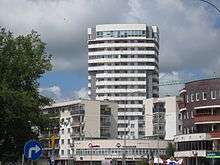
In the nineteenth century Białystok was an important center for light industry, which was the reason for the substantial growth of the city's population. The tradition continued with many garment factories established in the twentieth century, such as Fasty in the district of Bacieczki. However, after the fall of communism in 1989 many of these factories faced severe problems and subsequently closed down.
The unemployment rate for February 2011 in Białystok was 13.2%.[102] The 2009 average household had a monthly per capita income of 1018.77 zł [103] and monthly per capita expenses of 823.56 zł[104]
The city has a number of nearby border crossings.[105] The border with Belarus is only 50 km (31 mi) away, the nearest border crossings are located in; Bobrowniki (road crossing located about 50 km (31 mi) from the city limits), Kuźnica Białostocka (road and rail crossing located 60 km (37 mi) from the city limits), Siemianówka (railway – freight traffic), Połowce (road) and Czeremcha (railway).[105] Since the border with Belarus is also the eastern border of the European Union, as well as the Schengen Area the city is a center for trade in mainly from the east.[105]
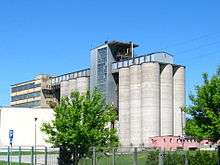
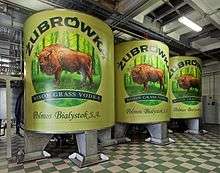
The leading industries in the city's economy are: food processing (production of meat products, fruit and vegetable products, the production of spirits, the production of frozen food, grain processing), electrical engineering (production tools and equipment for machine tools, production of electric heaters, manufacture and production mixers household appliances).[105] There is also a developed machine industry (electronics, machinery and metal), plastic processing (production of household appliances), textiles (textiles and upholstery, manufacture of underwear, clothing accessories, footwear and backpacks), Wood (production plywood and furniture) building materials.[105]
Some major employers who are based in Białystok include:
- Dojlidy Brewery in the district of Dojlidy produces the second most popular beer in Poland, Żubr.[106]
- Polmos Białystok, the biggest vodka manufacturer in Poland, is located in the city district of Starosielce.[107] The company produces Absolwent and Żubrówka (bison grass vodka) – both major exports abroad.[107]
- Standard Motor Products Poland Ltd. headquartered in Białystok began manufacturing ignition coils for original equipment manufacturers 30 years ago.[108]
- "Supon" Białystok is the leading Polish producer of fire fighting equipment.[109]
- SavaPol, Sp.z o.o. is a manufacturer of stationary and mobile concrete mixing equipment based in Białystok.[110]
- Biazet S.A. is a large manufacture of household appliances, including vacuum cleaners, coffee makers, and LED lighting located in Białystok.[111]
- Agnella, a major Polish producer of carpets and similar products is in Białystok, located in the district of Białostoczek.[112]
- Rosti Poland Sp. z o.o., has provided for more than 60 years precision injection molded products for some of the world's leading brands.[113]
- Biaglass Huta Szkla Białystok Sp. z o.o., established in 1929, produces mouth blown glass lampshades and related products. Biaglass belongs to elite group of Glass Works in Europe, where 100% of the lighting glass is mouth-blown.[114]
- Chłodnia Białystok S.A (Cold Store Białystok S.A.), established in 1952, is one of the largest Polish producers of frozen vegetables, fruits and ready-to-heat meals.[115]
- Podlaskie Zakłady Zbożowe S.A. was established on 1 July 2000 as a result of privatizing The Regional Establishment of Corn and Milling Industry 'PZZ' in Białystok. It is one of the leading firms in Podlaskie region in the department of preservation and processing of grain with elevators in Białystok, Grajewo and Suwałki.[116]
Culture and tourism
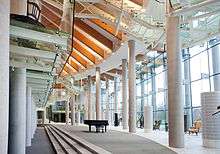
Białystok is one of the largest cultural centers in the Podlaskie Voivodeship. The attractions include performing arts groups, art museums, historical museums, walking tours of architectural / cultural aspects and a wide variety of parks and green spaces. Białystok in 2010 was on the short-list, but ultimately lost the competition, to become a finalist for European Capital of Culture in 2016.[117]
Performing arts
The city has a number of performing arts facilities including:
The Białystok Puppet Theater (Polish: Bialostocki Teatr Lalek), established in 1953, is one of the oldest Polish puppet theaters.[118] The facility is located at Kalinowskiego 1 in Białystok. The repertoire includes performances for both children and puppet adaptations of world literature for adults.[118] Because of the high artistic level of productions, the theater has been recognized as one of the best puppetry arts centers in Poland.[118]
The Aleksandra Węgierki Drama Theatre, housed in a building designed by Jarosław Girina, was built in the years 1933–1938.[119]
The Podlasie Opera and Philharmonic – European Art Centre in Białystok is the largest institute of arts in Northeastern Poland, and the most modern cultural center in this region of Europe. In its amphitheatre every year in the end of June Halfway Festival takes place.[120]
Museums
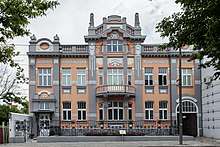
There are a number of museums in the city including:
The Historical Museum in Białystok (Polish: Muzeum Historyczne w Białymstoku) is part of the Podlaskie Museum.[121] The facility has a rich collection of archival materials and iconography illustrating the history of Białystok and Podlasie, and a number of middle-class cultural relics, especially in the field of craft utility.[121] There are also the Numismatic Cabinet of the collection of 16 000 coins, medals and securities.[121] The museum is in possession of the only collections in the country memorabilia connected with the Tatar settlement on the Polish–Lithuanian–Belarusian region.[121]
The Army Museum in Białystok (Polish: Muzeum Wojska w Białymstoku) was established in September 1968 as a branch of the Podlaskie Museum to house the research and collections of many people connected with military history of north-eastern Poland.[122]
The Ludwik Zamenhof Centre (Polish: Centrum im. Ludwika Zamenhofa w Białymstoku) has a permanent exhibition, "Bialystok of Young Ludwik Zamenhof", and various temporary exhibitions, concerts, film projections, and theatre performances. The Centre has a branch of Lukasz Gornicki’s Podlaska Library dedicated to the Esperanto language.
.jpg)
Parks and green spaces
Around 32% of the city is occupied by parks, squares and forest preserves which creates a unique and healthy climate.[123] The green spaces include:
Branicki Palace (Polish: Pałac Branickich) is a historical edifice and 9.7 ha (24 acres) park in Białystok. It was developed on the site of an earlier building in the first half of the eighteenth century by Jan Klemens Branicki, a wealthy Polish–Lithuanian Commonwealth hetman, into a residence suitable for a man whose ambition was to be elected king of Poland.[124] The palace complex with gardens, pavillons, sculptures, outbuildings and other structures and the city with churches, city hall and monastery, all built almost at the same time according to French models was the reason why the city was known in the eighteenth century as Versailles of Podlaskie (Polish: wersalem podlaskim).[125][126]
Planty is a 14.94 ha (36.9 acres) park created between 1930 and 1938, under the auspices of the then Voivode Kościałkowskiego Mariana Zyndrama in the areas adjacent to Branicki Palace.[127] The modernist composition of the park was designed by Stanislav Gralla.[128]
Architecture
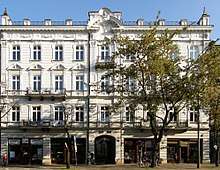
The various historically driven changes have had a very significant influence on the architectural space of the city. Most other Polish cities have suffered similarly, but the processes in Białystok, have had a particularly intense course. Numerous historic works of architecture no longer exist, while many others have been rebuilt to their original configuration. Very few historic buildings of the city have been preserved – the sights are merely an echo of the old historical shape of Białystok.[129]
Main sights include:
- Palaces: Branicki Palace, Branicki Guest Palace, Lubomirski Palace, Hasbach Palace, Nowik Palace
- Town hall
- Catholic Cathedral
- St. Roch Church
- St. Adalbert Church
- Orthodox Cathedral
- Daughters of Charity Monastery
- Former Arsenal
- Former Masonic Lodge
 Kościuszko Square with the Town Hall
Kościuszko Square with the Town Hall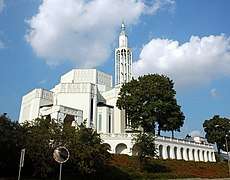 Church of St. Roch
Church of St. Roch St. Adalbert Church
St. Adalbert Church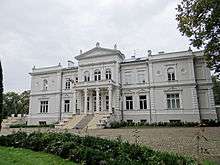 Lubomirski Palace
Lubomirski Palace- Former Masonic Lodge
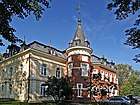 Hasbach Palace
Hasbach Palace
Sports
The city has both professional and amateur sports teams, and a number of venues where they are based. Jagiellonia Białystok is a Polish football club, based in Białystok, in the Ekstraklasa (Poland's top division) that plays at the Białystok City Stadium.[130] Jagiellonia Białystok won the Polish Cup in 2010, Super Cup and qualified to play in the third round qualification of the UEFA Europa League.[131] A new 22,500 seat stadium was completed at the beginning of 2015.[132]
Hetman Białystok (formerly known as Gwardia Białystok) is a Polish football club based in Podlaskie Voivodeship.[133] They play in the Division IV or the (4th) League.[134]
Lowlanders Białystok is a football club, based in Białystok, that plays in the Polish American Football League (Polish: Polska Liga Futbolu Amerykańskiego) PLFA I Conference.[135] The Lowlanders were the champions of the PLFA II Conference in 2010 with a perfect season (8 wins in eight meetings). Because of the win they were advanced to the upper conference (PLFA I) in 2011.[135]
Media
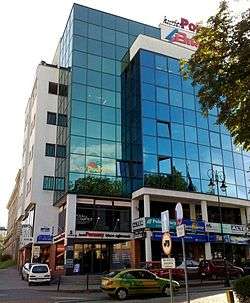
Białystok has a wide variety of media outlets serving the city and surrounding region. There are two locally published daily newspapers, Gazeta Współczesna (36.3% market share) [136][137] and Kurier Poranny (20.3% market share).[136][138] In addition two national papers have local bureaus. There are a number of national and locally produced television and radio channels available both over-the-air from the nearby RTCN Białystok (Krynice) Mast, the seventh highest structure in Poland,[139] in addition to transmitter sites within the city. TVP Białystok is one of the locally produced, regional branches of the TVP, Poland's public television broadcaster. There is also a cable television system available within the city. The city has two campus radio stations; Radiosupeł at the Medical University of Białystok[140] and Radio Akadera at Białystok Technical University.[141]
Religion
In the early 1900s, Białystok was reputed to have the largest concentration of Jews of all the cities in the world.[142] In 1931, 40,000 Jews lived in the city, nearly half the city's inhabitants.[143] The city is the seat of the Roman Catholic Archdiocese of Białystok. Pope John Paul II on 5 June 1991, during a visit to Białystok, announced the establishment of the Archdiocese of Białystok which ended the period of the temporary church administration of the portion of the Archdiocese of Vilnius that had, after World War II, remained within the Polish borders.[144] The city is also the seat of the Białystok-Gdansk Diocese of the Autocephalous Polish Orthodox Church.[145] Białystok is the largest concentration of Orthodox believers in Poland.[145] In Białystok, the following Protestant churches exist: a Lutheran parish, two Pentecostal churches, Baptist church, a congregation of the Church of God in Christ and a Seventh Day Adventist church.[146]
Białystok is home to more than two thousand Muslims (mainly Tatars). There is an Islamic Centre[147] a House of Prayer, and various organisations. There is magazine issued – "Pamięć i trwanie" ("Memory and persistence").
The city is the site of the Divine Mercy Sanctuary with the main relics of Michał Sopoćko.[148]
- Old Parish Church
- Basilica of the Assumption of the Blessed Virgin Mary
 Church of the Resurrection
Church of the Resurrection- All Saints' Church
- Orthodox Church of the Holy Spirit
- Eastern Orthodox Church of St. Nicholas in Lipowa Street
Transport
The city is and has been for centuries, the main hub of transportation for the Podlaskie Voivodeship and the entire northeastern section of Poland. It is a major city on the European Union roadways (Via Baltica)[149] and railways (Rail Baltica)[150] to the Baltic Republics and Finland. It is also a main gateway of trade with Belarus due to its proximity to the border and its current and longstanding relationship with Hrodna, Belarus.
A traffic management system has been operating in Białystok since 2015. At 120 intersections, traffic lights are coordinated in such a way that cars and buses covered the route as quickly as possible. Special cameras record traffic, travel time. Drivers receive this information on 19 boards set among others at the intersections on Wasilkowska Street, Antoniuk-Fabryczny Street and Kleeberga Street.[151]
Railways
Passenger trains connect from Suwałki, Grodno and Lithuania to Warsaw and the rest of the European passenger network. Passenger services are provided by two rail service providers, PKP Intercity that provides intercity passengers trains (express, intercity, eurocity, hotel and TLK)[152] and Przewozy Regionalne that operates only regional passenger trains financed by the voivodeship. Passenger trains are mostly run using electrical multiple units (on electrified lines) or rail buses.[153]
Buses
There is an extensive bus network that covers the entire city by three bus services, but no tram or subway exists. The three bus operators (KPKM, KPK and KZK) are owned by the city and each shares approximately a third of the lines and the bus fleet.[154]
Roads and highways
The National Roads (Polish: Droga krajowa) running through Białystok:








In Białystok there are also Poviat roads which connect the city with other towns in the area[155][156]:
- Poviat Road 1431 B: Białystok (42 Pułku Piechoty Street) - Sowlany
- Poviat Road 1432 B: Białystok (Ciołkowskiego and Baranowicka streets) - Zielona,
- Poviat Road 1483 B: Białystok (Filipowicza) - Hryniewicze
- Poviat Road 1484 B: Białystok (Mickiewicza Street) - Stanisławowo
- Poviat Road 1485 B: Białystok (Plażowa Street) - Dojlidy Górne
- Poviat Road 1493 B: Białystok (Wiosenna Street) - Olmonty
- Poviat Road 1535 B: Białystok (Popiełuszki, Hetmańska and Wierzbowa Streets) - Choroszcz
- Poviat road 1550 B: Białystok (Niewodnicka, Meksińska, Nowosielska and Elewatorska streets) - Klepacze - Niewodnica Kościelna,
- Poviat road 1559 B: Białystok - Kleosin
Bicycle
The municipal bicycle renting system is called BiKeR and was opened in 2014. System initially based on 30 stations equipped with 300 bikes. By 2018, there were already over 130 km of bicycle paths in Bialystok. The city has four bicycle repair stations, in which one can fix his private bikes. The stations are located in places where the highest traffic of city bikes was observed.[157]
Airports
A civil airport, Białystok-Krywlany Airport, lies within the city limits, but does not provide regularly scheduled service.[158] There were plans in 2011 to build a new regional airport, Białystok-Saniki Airport, that would have provided flights within Europe.[159]
Education
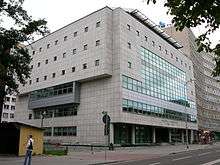
Higher education in the city can be traced back to the second half of the eighteenth century, when the ownership of the city was inherited by Field Crown Hetman Jan Klemens Branicki.[20] As a patron of the arts and sciences, Branicki encouraged numerous artists and scientists to settle in Białystok to take advantage of Branicki's patronage.[160] In 1745 Branicki established Poland's first military college, the School of Civil and Military Engineering, in the city.[160]
Since the fall of communism many privately funded institutions of higher educations have been founded and their number is still increasing. Currently Białystok is home to one principal public university (University of Białystok)[161] and two other public specialist universities (Białystok Technical University[162] and Medical University of Białystok[163]). Some institutions, such as Musical Academy in Białystok,[164] are branches of their parent institutions in other cities, usually in Warsaw.
Notable residents
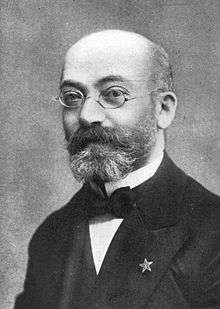
Over the centuries, a number of people from Białystok have been prominent in the fields of science, language, politics, religion, sports, visual arts and performing arts. This environment was created in the mid eighteenth century by the patronage of Jan Klemens Branicki for the arts and sciences.[160] These include Ryszard Kaczorowski, last émigré President of the Republic of Poland,[165] L. L. Zamenhof, the creator of Esperanto,[166] Albert Sabin, co-developer of the polio vaccine,[167] Izabella Scorupco, actress,[168] Max Weber, painter.[169] Tomasz Bagiński illustrator, animator and director Oscar nominee in 2002 for The Cathedral.
References
- "Insygnia Białegostoku". Archived from the original on 2011-08-17. Retrieved 2011-08-01.
- "Oficjalny portal miasta Białystok". bialystok.pl (in Polish). Retrieved 23 December 2018.
- "Local Data Bank". Statistics Poland. Retrieved 21 June 2020. Data for territorial unit 2061000.
- "Bialystok". Lexico UK Dictionary. Oxford University Press. Retrieved 3 August 2019.
- "Białystok". The American Heritage Dictionary of the English Language (5th ed.). Boston: Houghton Mifflin Harcourt. Retrieved 3 August 2019.
- "Białystok". Collins English Dictionary. HarperCollins. Retrieved 3 August 2019.
- "Białystok". Merriam-Webster Dictionary. Retrieved 3 August 2019.
- "Miasta w Dokumencie Archiwalnym". Archived from the original on October 26, 2010. Retrieved 2011-04-05.
- Nepokupnyj, A. P. (1970). Z movnoji spadščyny jatvjahiv. 5 (in Ukrainian). 6. Movoznavstvo. pp. 18–25.
- "Museums (Podlaskie Museum)". visitbialystok.com. Retrieved 2011-07-18.
- "Białystok – Local history". Muzeum Historii Żydów Polskich. Archived from the original on 2011-10-07. Retrieved 2011-07-18.
- "Miasta w Dokumencie Archiwalnym" (in Polish). Archived from the original on 2012-03-19. Retrieved 2011-04-05.
- Niewińska, Walentyna (1995). Legendy województwa białostockiego, łomżyńskiego, suwalskiego (in Polish). Białystok: Wojewódzka Biblioteka Publiczna im. Stefana Górnickiego w Białymstoku.
- Jacek Kusznier, Elektrycy w historii Politechniki Białostockiej, "Maszyny Elektryczne - Zeszyty Problemowe", Nr 4/2018, p. 163 (in Polish)
- "Czasy rodu Wiesiołowskich" (in Polish). Retrieved 2011-05-17.
- "Marszałkowie Sejmu" (in Polish). Retrieved 2011-05-17.
- Kądziela, Lukasz; Nagielski, Mirosław (1995). Hetmani Rzeczypospolitej Obojga Narodów (in Polish). Warsaw: Bellona. ISBN 83-11-08275-8.
- Kowalski, Waldemar (1999). Stefan Czarniecki : żołnierz, obywatel, polityk (in Polish). Kielce: Kieleckie Towarzystwo Naukowe. ISBN 83-86006-28-5.
- "History of the City". Archived from the original on 2011-08-15. Retrieved 2011-03-15.
- Magdalena Grassmann. "Podlaski Wersal Branickich". palac.amb (in Polish). Archived from the original on 2011-07-16. Retrieved 2011-04-15.
- "Miasto Białystok". wrotapodlasia.pl (in Polish). Archived from the original on 2008-04-11. Retrieved 2008-06-28.
- "Historia Białegostoku". bstok.pl (in Polish). Retrieved 24 October 2019.
- Jacek Kusznier, Elektrycy w historii Politechniki Białostockiej, "Maszyny Elektryczne - Zeszyty Problemowe", Nr 4/2018, p. 164 (in Polish)
- "Plejada gwiazd w nowym teatrze. Piotr Dąbrowski otwiera Komedialnię". Białystok Online (in Polish). Retrieved 24 October 2019.
- Jacek Kusznier, Elektrycy w historii Politechniki Białostockiej, "Maszyny Elektryczne - Zeszyty Problemowe", Nr 4/2018, p. 163-164 (in Polish)
- Cegielski, Tadeusz; Łukasz Kądziela (1990). Rozbiory Polski 1772-1793-1795 (in Polish). Warsaw.
- Piotr Stefan Wandycz (2001). The Price of Freedom: A History of East Central Europe from the Middle Ages to the Present. Routledge (UK). p. 133. ISBN 0-415-25491-4.
- The New annual register. 1808. pp. 276 (footnotes).
- Zimmerman, Joshua D. (2004). Poles, Jews, and the politics of nationality. Univ of Wisconsin Press. p. 16. ISBN 0-299-19464-7.
- "UWB Official website". Retrieved 2011-06-07.
- Samuel Joseph, Jewish Immigration to the United States, from 1881 to 1910, Columbia University, 1914, pgs. 65–66,
- Simon Dubnow, Israel Friedlaender, History of the Jews in Russia and Poland, Avotaynu Inc, 2000, pg 484,
- Sarah Abrevaya Stein, Making Jews Modern, Indiana University Press, 2004, pg. 113
- Geifman 1993, p. 127
- Avrich 2006, p. 44
- Gatrell, Peter. War Land on the Eastern Front: Culture, National Identity, and German Occupation in World War I.
- "Das Land Ober Ost" (in German). Archived from the original on 19 July 2011. Retrieved 2011-06-15.
- Maly rocznik statystyczny (Concise Statistical Year-Book of Poland) (in Polish). Warsaw: Central Statistical Office. 1939.
- "Podział Polski między ZSRR i Trzecią Rzeszę według Paktu Ribbentrop-Mołotow" (in Polish). Retrieved 2011-01-26.
- "Mapa podziału Polski. Podpisy: Stalin, Ribbentrop" (in Polish). Retrieved 2011-03-22.
- "Białystok". Encyklopedia PWN (in Polish). Retrieved 24 October 2019.
- "Budapest Review of Books". Books : Budapest Review of Books. Biuletyn IPN (in Polish) (12/2003-1/2004 ed.). Warsaw: IPN. nr 35-36. ISSN 1641-9561. OCLC 212382824.
- Gnatowski, M (1994). Białostockie Zgrupowanie Partyzanckie (in Polish). Białystok.
- "Bialystok". Holocaust Encyclopedia. United States Holocaust Memorial Museum. Archived from the original on 5 August 2007. Retrieved 2007-07-26.
- Mark, B (1952). Ruch oporu w getcie białostockim. Samoobrona-zagłada-powstanie (in Polish). Warsaw.
- "New Provinces of Poland (1998)". Archived from the original on 2011-06-08. Retrieved 2011-03-28.
- "Map of Poland". Archived from the original on 26 April 2011. Retrieved 2011-03-28.
- Jankowiak, S. Trudny "powrót do macierzy" (in Polish). IPN.
- Dziennik Ustaw (in Polish). 1975. p. 91.
- "Green Lungs Of Poland In 2006" (in Polish). Central Statistical Office, Warsaw. 2009. Archived from the original (PDF) on 2011-02-06. Retrieved 2011-01-12.
- Kondracki, Jerzy (2002). Geografia regionalna Polski (in Polish). Warszawa: PWN. ISBN 83-01-13897-1.
- "Białystok – Lasy". Białystok Miasto. Archived from the original on 2011-06-07. Retrieved 2011-06-09.
- "Knyszyń Forest Landscape Park" (in Polish). Retrieved 2011-03-25.
- "Białystok. Rezerwat – park Zwierzyniecki" (in Polish). Retrieved 2011-05-17.
- "Białystok portal miejski. Białostockie parki" (in Polish). Archived from the original on 2009-02-18. Retrieved 2011-03-05.
- "Zalew Dojlidy. Czas na zmiany". Gazeta Wyborcza Białystok. 2009-09-25. Retrieved 2011-06-09.
- "Białystok – Klimat – INFORMATOR BIAŁOSTOCKI" (in Polish). Retrieved 2011-03-05.
- "Weatherbase: Historical Weather for Białystok, Poland". Retrieved 2011-01-10.
- "Climate Białystok – Poland". Retrieved 2011-01-31.
- "Climate Białystok - Poland". Retrieved 2017-07-07.
- "Bialystok (12295) - WMO Weather Station". NOAA. Retrieved December 27, 2018.
- "Słoboda była wsią. Mieszkańcy mieli tu gospodarstwa". Kurier Poranny. 7 April 2014. Retrieved 29 August 2019.
- Tokajuk, Jerzy. Konflikty przestrzenne na styku istniejacej zabudowy zagrodowej i planowanej zabudowy mieszkaniowej na terenach wsi strefy podmiejskiej wlaczonych do obszaru miasta Bialoegostoku, pg. 312-313.
- "Bulletin of Białystok City Hall: City Council resolutions on the administrative division of the city" (in Polish). Retrieved 2011-06-08.
- "Division of the City of settlements" (in Polish). Archived from the original on 2011-05-04. Retrieved 2011-04-15.
- "Miejski System Informacji Przestrzennej (GIS)" (in Polish). Retrieved 2011-07-18.
- "Geodesic status and use of city land" (PDF) (in Polish). Archived from the original (PDF) on 2012-03-14. Retrieved 2011-04-16.
- "Rozporządzenie Nr 52/05 Wojewody Podlaskiego z dnia 16 maja 2005 r. w sprawie wyznaczenia aglomeracji Białystok (Dz. Urz. Woj. Podl. Nr 130, poz. 1547)" (PDF) (in Polish). Retrieved 2011-03-25.
- "Rozporządzenie Nr 5/06 Wojewody Podlaskiego z dnia 29 września 2006 r. w sprawie wyznaczenia aglomeracji Białystok (Dz. Urz. Woj. Podl. Nr 244, poz. 2383)" (PDF) (in Polish). Retrieved 2011-03-25.
- "Population. Size and Structure by Territorial Division, as of June 30, 2010" (in Polish). Central Statistical Office, Warsaw. 2010. Archived from the original on 17 July 2011. Retrieved 2011-08-01.
- "BIAŁYSTOK AGAINST THE BACKGROUND OF OTHER VOIVODSHIP CITIES IN 2009" (PDF) (in Polish). Archived from the original (PDF) on 2012-03-14. Retrieved 2011-02-24.
- Wróbel, Piotr (1989). "Na równi pochyłej. Żydzi Białegostoku w latach 1918-1939: demografia, ekonomika, dezintegracja, konflikty z Polakami (On the Downward Path. The Jews of Białystok in 1918-1939; Demography, Economy, Disintegration)" (PDF). Studia Podlaskie (in Polish). University of Białystok. 2: 167–168.
- "Drugi Powszechny Spis Ludności z dn. 9. XII 1931 r.: mieszkania i gospodarstwa domowe, ludność, stosunki zawodowe : województwo białostockie" (in Polish). GUS. 1938: 27. Cite journal requires
|journal=(help) - Levin, Don (1995). The Lesser of Two Evils: Eastern European Jewry under Soviet Rule, 1939-1941. The Jewish Publication Society. p. 21. ISBN 978-0827605183.
- Dānishgāh-i Tihrān. Faculty of Fine Arts (1990). International Conference on Reconstruction of War-Damaged Areas: 6–16 March 1986 : Faculty of Fine Arts, University of Tehran, Iran. University of Tehran Press. p. 148.
- "Statistical Yearbooks of Poland". Central Statistical Office, Warsaw. 2009. Archived from the original (PDF) on 10 December 2010. Retrieved 2011-01-12.
- "Dz.U. z 1998 r. nr 91, poz. 578 (Sjem of the RP)" (in Polish). Retrieved 2011-04-15.
- "Statut Miasta Białegostoku" (in Polish). Retrieved 2011-04-15.
- "Wyniki głosowania na kandydata w obwodach" (in Polish). pkw.gov.pl. Archived from the original on 2011-09-30. Retrieved 2011-08-01.
- "2010–2011 Budget Statement" (in Polish). Retrieved 2011-04-15.
- "Podlaskie Voivodeship website" (in Polish). Retrieved 2011-04-15.
- Nohlen, Dieter (2004). Prawo wyborcze i system partyjny. O teorii systemów wyborczych (in Polish). Warszawa: Scholar. p. 15. ISBN 83-7383-130-4.
- "The Act of 23rd January 2004 on Elections to the European Parliament" (in Polish). Archived from the original on 2011-07-16. Retrieved 2011-04-15.
- "Polish National Election Commission 2004" (PDF) (in Polish). Archived (PDF) from the original on 16 May 2011. Retrieved 2011-04-15.
- "Relaţii bilaterale – Scurt istoric" [Bilateral relations – brief history] (in Romanian). Romanian Foreign Ministry – Romanian Embassy to Poland. Retrieved 2012-11-21.
- "Konsulat Finlandii". Podlaska Fundacja Rozwoju Regionalnego (in Polish). Retrieved 2020-01-18.
- "Ambasady i Konsulaty | odkryj.bialystok.pl". odkryj.bialystok.pl. Retrieved 2020-01-18.
- "UMP". UMP. Archived from the original on 2013-10-29. Retrieved 2013-10-24.
- "Euroregion Niemen" (in Polish). Archived from the original on 24 July 2011. Retrieved 2011-08-01.
- "KRS – Podmiot nr: 0000060828, STOWARZYSZENIE EUROREGION NIEMEN" (in Polish). Archived from the original on 2012-02-04. Retrieved 2011-08-01.
- "Polish Green Lungs Foundation" (in Polish). Zielone Płuca Polski. Retrieved 2011-08-01.
- "Eurocities Membership List". Eurocities. Retrieved 2013-10-24.
- "Ville de Dijon – Dijon, une politique renouvelée à l'international". Dijon.fr. Archived from the original on 2013-10-02. Retrieved 2013-10-04.
- "Ville de Dijon – Jumelages". Dijon.fr. Archived from the original on 2013-06-02. Retrieved 2013-10-04.
- "Sister Cities International". Archived from the original on 2013-10-29. Retrieved 2013-10-24.
- Korolczuk, Dariusz (12 January 2010). "Foreign cooperation – Partner Cities". Białystok City Council. City Office in Białystok. Archived from the original on 11 July 2015. Retrieved 2013-03-22.
- "Od kolei do Wielkiego Białegostoku" (url) (in Polish). Retrieved 2019-12-17.
- Poranny Kurier. "Wysoki Stoczek. Reduta to pomnik chwały tych, którzy chcieli podjąć walkę, uratować honor miasta" (url) (in Polish). Retrieved 2019-12-18.
- "Dziennik Urzędowy Ministra Obrony Narodowej, 2009" (PDF) (in Polish). Archived from the original (PDF) on 2012-01-19. Retrieved 2011-04-15.
- Giętkowski, Miroslaw (2001). Riding the Polish Army Artillery 1918–1939 (in Polish). Toruń: Adam Marszałek. ISBN 83-7174-823-X.
- Jurga, Tadeusz (1975). Polish Army: a brief informant history of the Polish Army during World War II (in Polish). New York: Ministerstwa Obrony Narodowej.
- "Podlaskie Voivodeship Labor Office (Wojewódzki Urząd Pracy w Białymstoku)" (in Polish). Retrieved 2011-04-15.
- "2009 Household income" (PDF) (in Polish). Archived from the original (PDF) on 2012-03-14. Retrieved 2011-04-15.
- "2009 Household expenses" (PDF) (in Polish). Archived from the original (PDF) on 2012-03-14. Retrieved 2011-04-15.
- "Economic Profile of Białystok". Archived from the original on 2011-08-15. Retrieved 2011-04-15.
- "SABMiller overview of operations". Archived from the original on 2012-12-16. Retrieved 2011-04-15.
- "Strona producenta – raport sprzedaży" (PDF) (in Polish). Archived from the original (PDF) on September 29, 2007. Retrieved 2011-04-15.
- "SMP Motor Corp". Retrieved 2011-04-15.
- ""SUPON" BIAŁYSTOK" (in Polish). Retrieved 2011-04-15.
- "SavaPol". Archived from the original on August 16, 2011. Retrieved 2013-11-22.
- "Biazet" (in Polish). Retrieved 2011-04-15.
- "Agnella" (in Polish). Retrieved 2011-04-15.
- "Rosti". Archived from the original on 2011-07-15. Retrieved 2011-04-15.
- "Biaglass Glass Works" (in Polish). Retrieved 2011-04-15.
- "Chłodnia Białystok S.A" (in Polish). Retrieved 2011-06-16.
- "Podlaskie Zakłady Zbożowe S.A." (in Polish). Retrieved 2011-06-16.
- "Białystok 2016" (in Polish). Retrieved 2011-04-15.
- "Białystok Puppet Theater" (in Polish). Archived from the original on 2008-05-15. Retrieved 2011-04-15.
- "Z sesji miejskiej. PiS przegrał z Węgierką" (in Polish). Archived from the original on 2007-12-08. Retrieved 2011-04-15.
- "Official Website of The Podlasie Opera and Philharmonic". Archived from the original on 2015-02-04. Retrieved 2015-02-04.
- "Oficjalna strona Muzeum Podlaskiego" (in Polish). Retrieved 2011-04-15.
- "Muzeum Wojska w Białymstoku" (in Polish). Retrieved 2011-04-15.[ ]
- "Białystok portal miejski. Parki, skwery i zieleńce" (in Polish). Archived from the original on 2012-03-22. Retrieved 2011-08-01.[ .]
- "Podlaski Wersal Branickich". palac.amb.edu.pl (in Polish). Archived from the original on 2011-07-16. Retrieved 2009-11-26.
- "Widok zespołu parkowo – pałacowego z "lotu ptaka"" (in Polish). Archived from the original on 2011-05-04. Retrieved 2011-04-15.
- "Zielony Białystok – Ogród Branickich" (in Polish). Archived from the original on 2011-08-17. Retrieved 2011-04-15.
- "Rejestr zabytków województwa podlaskiego" (PDF) (in Polish). 2011-03-25. Archived from the original (PDF) on 2012-02-04.
- "Akcja Planty, czyli jak za dawnych lat" (in Polish). Retrieved 2011-04-15.
- "Białystok 2006–2010" (in Polish). Archived from the original on 2011-08-16. Retrieved 2011-05-23.
- "Jagiellonia Białystok" (in Polish). Retrieved 5 January 2011.
- "Results of UEFA Europa League match". Archived from the original on 2010-07-22. Retrieved 2011-04-15.
- "Press release on new stadium" (in Polish). Archived from the original on 2011-06-15. Retrieved 2011-04-15.
- Hetman Białystok web page (in Polish)
- "Polish Soccer Podlaskie Regional Association" (in Polish). Archived from the original on 15 May 2011. Retrieved 2011-04-15.
- "Białystok Lowlanders" (in Polish). Retrieved 2011-04-15.
- "February 2010, published by Związek Kontroli Dystrybucji Prasy (The Board of Press Distribution Control)" (in Polish). Archived from the original on 26 April 2011. Retrieved 2011-04-16.
- "Gazeta Współczesna" (in Polish). Archived from the original on 30 April 2011. Retrieved 2011-04-15.
- "Kurier Poranny" (in Polish). Archived from the original on 23 April 2011. Retrieved 2011-04-15.
- ""Mostostal Zabrze" ZMP "KATOWICE" Sp.z o.o. — Obiekty wysokościowe" (in Polish). Archived from the original on 2012-10-11.
- "Radiosupeł at the Medical University of Białystok" (in Polish). Archived from the original on 2011-09-23. Retrieved 2011-04-15.
- "Radio Akadera at Białystok Technical University" (in Polish). Retrieved 2011-04-15.
- Gruber, Ruth Ellen (2002). Virtually Jewish: Reinventing Jewish Culture in Europe. Berkeley, Calif.: University of California Press. p. 96. ISBN 0-520-21363-7.
- Feierstein, Daniel (2005). "The Jewish Resistance Movements in the Ghettos of Eastern Europe". In Sterling, Eric J. (ed.). Life in the Ghettos During the Holocaust. Syracuse, N.Y.: Syracuse University Press. p. 226. ISBN 0-8156-0803-9.
- "Archidiecezja Białostocka" (in Polish). Retrieved 2011-04-15.
- "Polish Orthodox Diocese of Białystok-Gdańsk" (in Polish). Retrieved 2011-04-15.
- "w Kościele Zielonoświątkowym "Dobra Nowina" ul. Kraszewskiego 37" (in Polish). Retrieved 2011-04-15.
- Białystok Islamic Centre,
- The Congregation of the Sisters of Our Lady of Mercy
- "Via Baltica: Los drogi niepewny. Nie ma gwarancji finansowania" (in Polish). Gazeta Wspolczesna. 2013-10-13. Retrieved 2011-04-15.
- European Commission, Directorate-General Regional Policy (January 2007). "Feasibility study on Rail Baltica railways" (PDF). Retrieved 2011-04-16.
- Patrycja Piórkowska. Komunikacja miejska jako element systemu transportowego miasta Białystok – wyniki badań, p. 110
- "PKP Intercity" (in Polish). Retrieved 23 January 2010.
- "Przewozy Regionalne" (in Polish). Archived from the original on 11 January 2016. Retrieved 2010-01-23.
- "Transport No.UT-5, page 3" (PDF). World Bank. April 1996. Retrieved 2011-04-15.
- Patrycja Piórkowska. Komunikacja miejska jako element systemu transportowego miasta Białystok – wyniki badań, p. 106
- Drogi powiatowe
- Patrycja Piórkowska. Komunikacja miejska jako element systemu transportowego miasta Białystok – wyniki badań, p. 110
- "Aeroklub Białostocki" (in Polish). Retrieved 2011-01-29.
- "Białystok-Saniki Airport" (in Polish). Archived from the original on June 20, 2013. Retrieved 2013-10-24.
- Sztachelska-Kokoczka, Alina (2006). "Magnackie dobra Jana Klemensa Branickiego" (in Polish). Retrieved 2011-04-15.
- Act of Sejm of the Republic of Poland on June 19, 1997 (in Polish)
- "Białystok Technical University History". Archived from the original on 2013-04-24. Retrieved 2011-04-15.
- "Medical University of Białystok History" (in Polish). Archived from the original on 22 April 2011. Retrieved 2011-04-15.
- "Musical Academy in Białystok" (in Polish). Archived from the original on 2011-03-12. Retrieved 2011-04-15.
- Stachura, Peter D. (2004). The Poles in Britain 1940–2000. 1358 (Paperback First ed.). London: Frank Cass. p. 45. ISBN 0-7146-8444-9.
- "Jewish Heritage Trail in Białystok" (in Polish). July 25, 2009. Retrieved 2009-07-25.
- Horaud, F (December 1993). "Albert B. Sabin and the development of oral poliovaccine". Biologicals. 21 (4): 311–6. doi:10.1006/biol.1993.1089. PMID 8024745.
- "Profile/Biography of Izabella Scorupco". Archived from the original on 2011-07-16. Retrieved 2011-01-25.
- North, P. (1991). Max Weber: the cubist decade, 1910–1920. Atlanta: High Museum of Art.
Further reading
- Łukasz Kaźmierczak, Trzy procent odmienności (Three percent of different) – article describing results of Polish census 2002 and minorities in Poland, citing census data (in Polish)
- Janusz Żarnowski, "Społeczeństwo Drugiej Rzeczypospolitej 1918–1939", Warszawa 1973 (in Polish)
- Eugeniusz Mironowicz, "Białoruś", Trio, Warszawa, 1999, ISBN 83-85660-82-8 (in Polish)
- Yvette Walczak, "Let Her Go!", Naomi Roth Publishing, London, 2012, ISBN 978-0-9537585-2-4
External links
| Wikimedia Commons has media related to Białystok. |
| Look up Białystok in Wiktionary, the free dictionary. |

- Osiedla.Białystok.pl (in Polish)
- VisitBiałystok.com (in Polish, English, and Russian)
- Białystok's official website at the Wayback Machine (archived February 22, 2013) (in English and Polish)
- Official Site Białystok City Transport (in Polish)
- Google Transit in Białystok
- Białystok, Poland at JewishGen
- Białystok at the B&F Compendium of Jewish Genealogy
